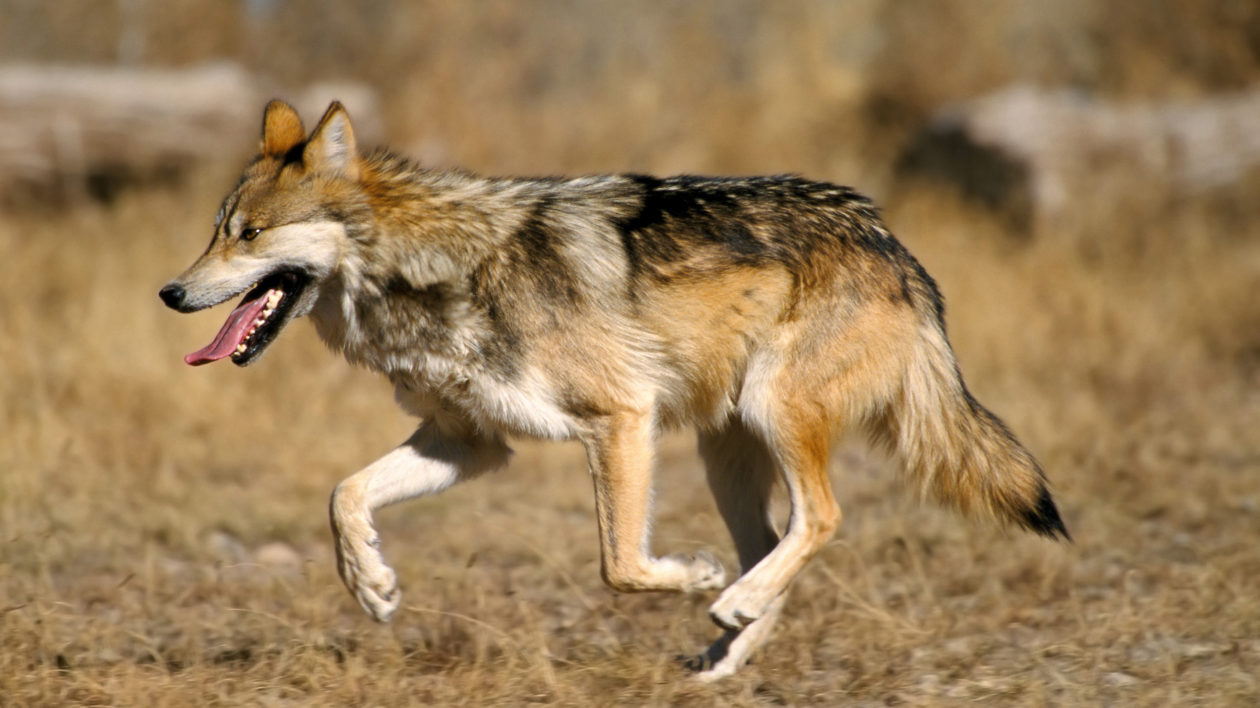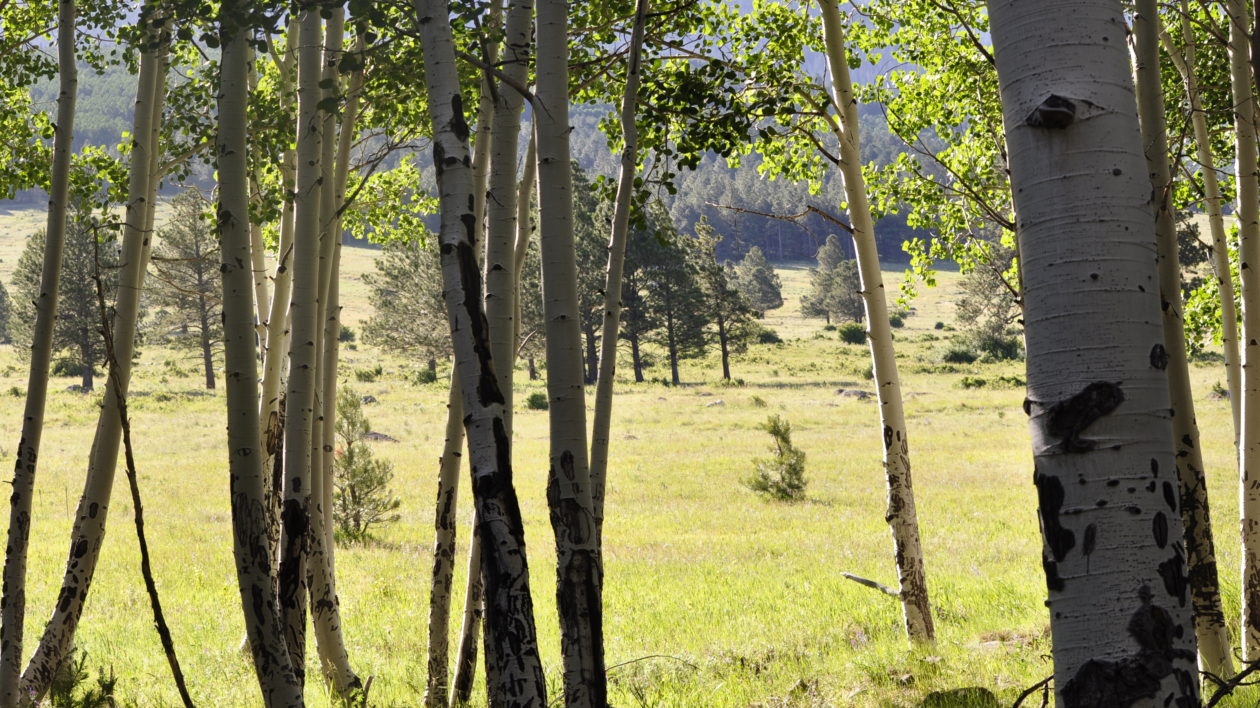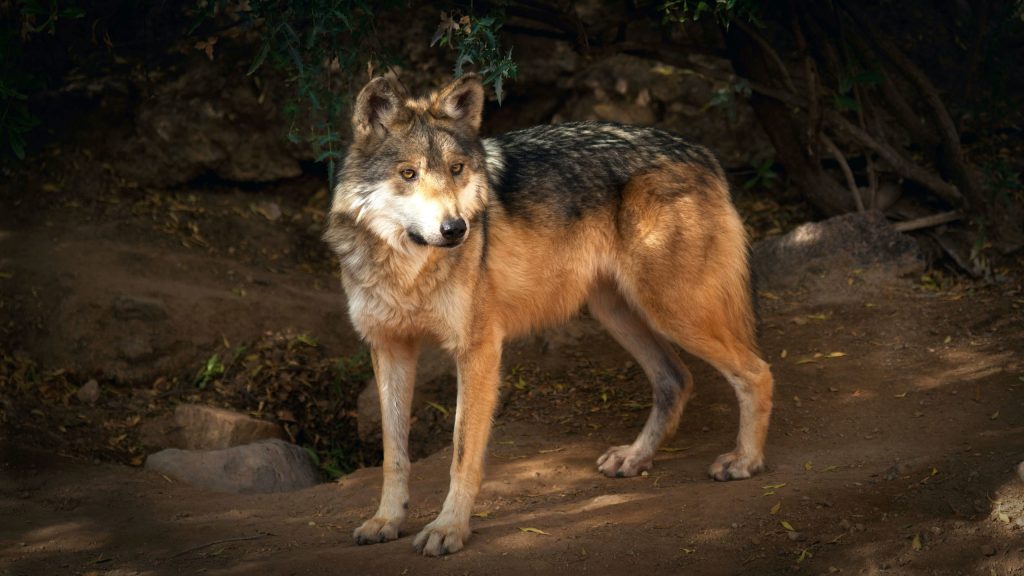The Nature Conservancy’s Joel Jurgens lives with his wife and two boys in the forested mountains west of Flagstaff. They are less than a mile from Chimney Springs in the Coconino National Forest, where TNC recently completed a forest restoration project. It’s also a popular hiking, biking and recreation spot.
I called Joel while working on a story on forest restoration work for The Nature Conservancy in Arizona’s newsletter. Story selection for newsletters is always complicated, but how do you make a story on forest management relevant during a pandemic? Rather than focusing on the “how” of what we’re doing, I wanted the “why.” That led me to Joel, and I’m glad I called. Boy, did he have a story.
One morning in mid-February, Joel’s wife Nicky and their dog Belle went out for their morning run through Chimney Springs. About six miles in, Nicky stopped for a breather and to take in the view, at which point she locked eyes with a large canine high above the trail.

Assuming it was a coyote and unsure how to proceed around this animal, she turned to jog towards home. The “coyote” followed, stalking her, or more likely, her female dog, from about 40 feet behind, all the way down the path. No shouting, screaming or twig throwing would distract it.
Soon she came upon another runner and her dog, and warned her about the “large coyote” stalking her. Nicky’s friend, who has been running these trails for 20 years, took one look and said, “that is no coyote, that’s a Mexican grey wolf.” The suspected wolf followed them until they reached a logger’s camp, at which point the wolf turned and left.
When Nicky got home, she called Joel, who admitted his initial thought was “yeah sure.” However, he reached out to his contact at Arizona Game and Fish and was told that if this report had come in just a few years prior, disbelief would have prevailed. Turns out that images had been captured of a very large, lone male canine, just 20 miles west of Chimney Springs, two days later.

Wolf Walkabout
The consensus: A lone Mexican grey wolf on a walk-about, hundreds of miles from where his forebears were re-introduced back in 1998: Arizona’s White Mountains on the border with New Mexico.
There are more Mexican grey wolves in the wild now than at any time since reintroduction began. The latest survey shows there are at least 163 wolves in New Mexico and Arizona, a nearly 25 percent jump from the previous year.
When large predators like wolves exceed their pack size, the younger, non-mating males tend to wander to seek mates elsewhere. They go where they can find prey. Wolves are carnivores and prey on elk, deer, rabbits and various other small animals. Their kills benefit many other wildlife, such as ravens, coyotes, eagles and other creatures that also consume the remains.
Historically, “before we started suppressing fire, our forests were more open; there were more meadows, with forbs and grasses that would likely attract and support more prey species and other wildlife,” said Joel, who oversees TNC’s forest restoration work in Arizona.
We can’t say for certain that the wolf was in the Chimney Springs area because of our recent restoration work. But we can say that restoring the forest is helping it become healthier more resilient, which tends to attract all manner of wildlife. Including those creatures at the top of the food chain.
During this time of physical distancing, it’s re-assuring that this lone wolf, one of the rarest species on the planet, chose to meander through a restored forest in Arizona, perhaps finding food and rest in our neck of the woods.

Leopold Country
Mexican grey wolves were first introduced in Arizona in 1998 into the Blue Range in east-central Arizona. It’s ironic that the Blue Range was where during the early part of the century, Aldo Leopold, today one of the guiding spirits of the American conservation movement, first came to know the Southwest.
Before Leopold made his many contributions to conservation, he worked as a government hunter, and killed dozens of wolves in the area. He came to regret his work only after he mortally wounded an aged female, failing to make what hunters call a clean kill.
“We reached the old wolf in time to watch a fierce green fire dying in her eyes,” he wrote in his now-classic memoir A Sand County Almanac. “I realized then and have known ever since that there was something new to me in those eyes — something known only to her and the mountain. I was young then, and full of trigger itch; I thought that because fewer wolves meant more deer, that no wolves would mean hunter’s paradise. But after seeing the green fire die, I sensed that neither the wolf nor the mountain agreed with such a view.”




I have seen these wolves in yavapai and coconino and sadly most dismiss them as . Large coyote animals…so sad will be the day when people that dismiss what I have told them when they meet face to face with their large coyote who BTW isn’t afraid of anything unlike the timid coyotes that are really a little smaller than the mexican grey.
Thank you for this article. What a great read.
I am born and raised in Arizona. I have seen many coyotes. I know coyotes are bigger in Northern Arizona. A few weeks ago I was in Oak Creek Canyon on the porch. The sun was setting and I heard howling in the distance. A bit later we saw something white but it didn’t move. It is so dark because of the light ordinances. Maybe 10 minutes later it started to move towards us. Got as close as 15 feet away before we made it inside. I have been told that it was a coyote but everything in me says that it was a Mexican Grey Wolf.
How interesting that you quoted Leopold the wolf killer, who was instrumental in extirpating the essentially ecologically similar wolf from AZ, NM.
Spare the world the pratings of retired butchers who found religion, AFTER they had done their destruction.
And then, in this excessively gushing article, you helped, yourself, to prevent proper and safe dispersal through plastering it in the media.
Further, your inaccurate article clearly failed to point out that young females also disperse long distances for the same reason stated as males.
The private self-interest groups controlling AZ antiwolf policy ( see the purposely false research done by AZ DFG’s Heffelfinger, as illustration) can now weapon use the corrupt 10j rule to prevent this wolf’s survival and presence in their ancestral habits, which once extended into California’s Mojave – the last wolf murdered in CA by gunfags was a similar wolf in the early1920s in the Providence massif.
Thanks for your comment. At the time of Aldo Leopold’s writing, anti-predator policy was considered “sound science.” Leopold was reflective of the anti-predator values that characterized Western science of the day. He had an awakening, and changed his opinion. I highly suggest you read “Thinking Like a Mountain,” his essay on the subject. It remains one of the most powerful essays ever written on conservation. I also highly recommend Julianne Lutz Newton’s book Aldo Leopold’s Odyssey. In it, she shows Leopold’s intellectual journey including his openness to changing his opinion. Without people willing to change opinions, conservation would have no hope whatsoever. While Leopold had his failings, as all of us do, I would hope his intellectual journey and willingness to change is an inspiration for all of us who value science.
Best,
Matt Miller
Editor, Cool Green Science
So good to hear, I hope their range is expanding. I’ll be up in the Flagstaff area tomorrow, maybe I’ll try to find this area. It looks beautiful.
Beautiful article!
Wonderful story. Thanks.
I appreciate the article about the lone wolf but am also now extremely concerned for its life. Someone will now inevitably search the area mentioned and pride themself in killing such a unique life. I often wish reporting was more discrete. The was an interesting article, but readers don’t need a road map.
I so agree, killing wolves is such an ignorant act of cruelty, they have as much right to live their lives as any creature on the planet, too bad humans are so terrified of the wolf and want to hurt and kill them with guns
This is No surprise to me. Some years ago I worked as a security guard, we would do inspections of buildings by walking around them. At one building a grey wolf would join me daily for at least one of my inspection rounds. He never got close but was actually quite comfortable having around. I have a 1/2 wolf 1/2 huskie currently and have had another 3/4 wolf 1/4 German Shepard many years ago. Both animals have been wonderful companions and non aggressive. Seeing wolves in Arizona is no surprise.
I
Unfortunately it is my understanding that Wolves and Bears are NOT protected species across America, Washington State fore sure. It is the same situation in Canada, BC for sure.
Many people are sick and tired of the senseless killing of these beautiful and important animals in terms of ecosystem balance. Numerous petitions have, and still being sent to the government agencies responsible. Regrettably their responses are totally bogus and these officials give reasons that are ridiculous and unproven and demonstrates their total lack of understanding about our ecological system.
The conservation staff are trigger happy and continuously shoot bears without cause for the most part. Reasons given are pathetic and their actions highly questionable. Hunters are free to hunt and shoot our Wolves . It is sickening. It is unneccary. We encroach further and further into animals’ environments.
The situation in BC and Washington State are similar in many ways, and the actions taken are untenable.
In the name of God, stop this needless killing. Hold humans accountable and issue the highest of fines if they are in any way responsible for urbanising bears. Look at other countries where they protect their wildlife, e.g., Austria. Stop cowtowing to people with money and animal stock. Make them responsible for protecting their livestock, penalize them if they cannot prove they are acting responsibly to protect their livestock,and stop responding to them by killing our wolves. The farmers have responsibilities too.
Step up to the plate and act responsibly without or vested interests. pamelaH
J
It is the height of human hubris to presume that a wolf is stalking oneself. This incredible vanity and arrogance is belied EVERY DAY by the behaviors of their very own dogs, whose cognitive attention becomes SOLELY fixated or focused upon others of THEIR OWN species, even as the humans scream in response.
It is journalists’ duty to added bracketed or ellipsis words such as: alleged and vanishingly unlikely, when quoting such narcissistic tripe as the quoted individuals when they assert this. I have traveled with ambassador wolf, and noted that even curious wild wolves tend to shield themselves from view , observing, when possible.
Unpaired subadult and young adult dispersing wolves are certainly more fixated on their conspecifics (dogs in th e present cases); so much so due to their obligate sociality and consequent desire for teh company of their own.
Wolves are not aggressive toward dogs when the former are alone, often even seeking out the company of coyotes when far from natal pack for the first time.
Only when a wolf smells, or has developed “search image” from previous encounter with coyotes, might [s]he act in their territorially exclusiveway toward THAT species, which are different pheromonally and hormonally from Canis lupus an d subspecies familiaris.
This brings tears to my eyes. I have always loved wolves. I have said many times in my 74 yrs. that this world would be a better place without humans.
Thank You for this ray of hope story.
Pretty sad how long it has taken us (humans) to learn that killing off predators destroys nature rather than saving it. We NEED those wolves, mountain lions, coyotes, bears & smaller predators – without them the environment & nature itself just isnt healthy.
When you think of all the species – not only predators – that have been slaughtered or, as humans sometimes call it, culled – its really depressing.
Hopefully – after all these years – we have actually gained a bit of intelligence!
The articles & writers here are helping in that.
Great story!